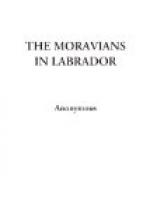On purpose to further the prosecution of this object, M. Stach, the first Greenland missionary, had been recalled to Europe, and in the year 1752 was sent for to London by Count Zinzendorff, to be consulted with upon the occasion. Application was at the same time made to the Hudson’s Bay Company, for permission to preach the gospel to the savages in the neighbourhood of their factories; but this being refused, probably lest it should interfere with their mercantile projects, M. Stach returned to found new settlements near the scenes of his first labours. Meanwhile, three London merchants, but unconnected with the Hudson’s Bay Company, Messrs Nisbet, Grace and Bell, fitted out a vessel for the coast of Labrador, to trade in oil and whale fins, and engaged Erhardt, then at Zeist, to act as supercargo, who, on account of his knowledge of the north seas, of the trade, and of the language, they judged well qualified for that office; but they also wished to make some preparation for a missionary settlement, and four brethren, Golkowsky, Kunz, Post, and Krumm, volunteered to remain in the country to learn the language, and endeavour the conversion of the heathen; for this purpose they took with them a wooden house ready to set up, a boat, various articles of furniture, and some kitchen garden-seeds.
Count Zinzendorff, who, from former experience, was opposed to mixing trading transactions with the work of a Christian mission, was not without doubts as to the issue of this undertaking, he did not however attempt to prevent it. The vessel on board of which this small society embarked, named the Hope, reached the south-east coast of Labrador on the 11th July 1752. The whole is precipitous, and skirted with numerous barren rocky islands; among these they had to steer their way under many difficulties, and with the greatest caution, without any proper chart, in misty weather, and with the sounding line constantly in their hands. At length they landed, and proceeded in search of the Esquimaux in order to traffic with them. On the 29th July they made their first appearance in five kaiaks, which they managed with great dexterity, and seemed highly delighted with Erhardt, who, from his knowledge of the Greenlandish, could make himself understood by them. They exchanged some whale fins for knives. July 31 they came to anchor 55 deg. 31 m. N.L. in a beautiful harbour, surrounded by a wooded high land, and bounded by meadow grounds, to which, from respect to the chief owner of the ship, they gave the name of Nisbet’s Harbour.




